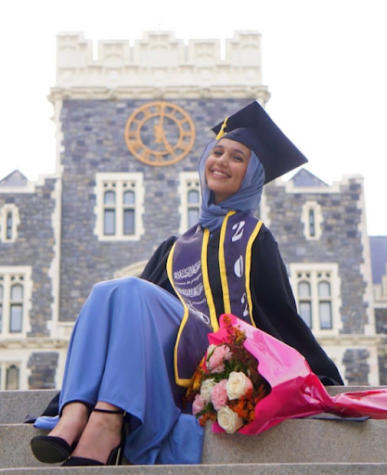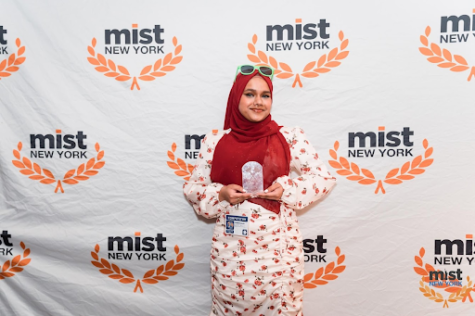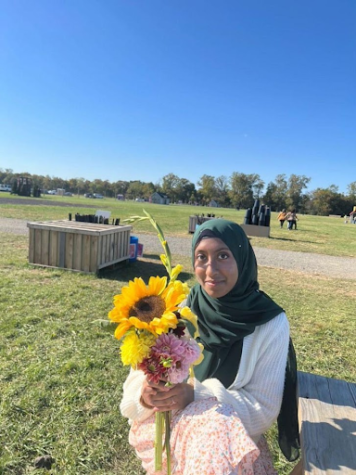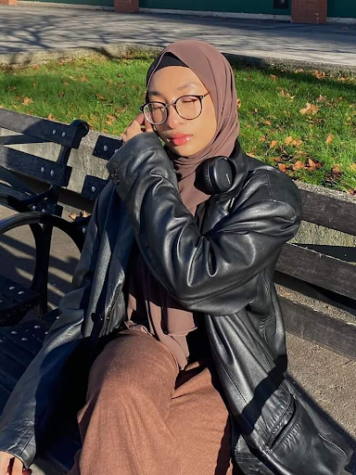A Mosaic of Hijabi Narratives
Society needs to be educated on the meaning of hijab, as people often perceive it with negative connotations. It is time to rewrite the hijabi narrative.
![The Muslim Students Association at Bronx Science is a safe haven for hijabis. Humairah Chowdhury ’23 mentioned how MSA “provided [her] with an escape from the stress of school.”](https://thesciencesurvey.com/wp-content/uploads/2023/04/unnamed.png)
Courtesy of Humairah Chowdhury '23
The Muslim Students’ Association at Bronx Science is a safe haven for hijabis. Humairah Chowdhury ’23 mentioned how MSA “provided [her] with an escape from the stress of school.”
There are more than two billion Muslims in the world. In this growing international community, there exists a multitude of Muslim women who wear the hijab daily.
The hijab, at its core, means to be modest. It is to cover one’s body in an intentional way that does not reveal it to others. The hijab is not simply a physical headscarf, but instead serves as a universal public expression of faith. However, the meaning of the hijab contains more depth and intricacy, differing from person to person.
I, for one, began wearing the hijab shortly after hitting puberty in fifth grade. Although I was surrounded by two female figures in my life who wore the hijab, my mother and my older sister, I did not internalize its importance until much later in life. Like other hijabis that I have spoken to, I did not take the hijab seriously, unable to understand its true purpose.
Some hijabis like Fatima Sanih, an engineering graduate from the City College of New York, had more nuanced conversations with their parents, discussing the best time to put on the hijab. This made it a lot easier for Fatima to wear the hijab when she did and fostered a love for the hijab at an early age. Sanih recalled her parents explaining to her, “[the hijab] is an obligation but you get to wear it whenever you are ready.” She continued, “So, I always knew that I had a choice of when I could wear it.” In the end, Sanih began her hijab journey in the eighth grade.
But that alone is a reassuring thought. Many individuals who are not familiar with the hijab may believe that it is forced upon everyone. On the contrary, a majority of Muslim girls, especially those living in the West, are given the opportunity and choice to wrap the hijab around their heads. Many take the choice willingly, aware of their obligation to Islam and Allah (God).
Yet, it is important to acknowledge that some hijabis wear the hijab because they are forced into doing so. This may be due to the fact that they live in a primarily Muslim country or the way their parents may feel about the hijab. Not to mention, a great number of women wear the hijab with no purpose in mind, never questioning the necessity for the hijab, remaining stagnant. In those cases, these are the hijabis who end up taking it off, their faith wavering. Humairah Chowdhury ’23, the current president of the Bronx Science MSA (Muslim Students’ Association), explains how integral it is to seek a spark: “If you don’t have a reason for wearing the hijab, then that plays a huge factor as to why you struggle with it in the first place. You are holding onto something that you don’t even want.”

At the same time, wearing the hijab becomes a responsibility that one lives with for the rest of their life. It is a binding action. When a girl begins her hijab journey, she has a responsibility to represent herself in a moral fashion but also her religion. “Wearing the hijab is more than just a cloth around our heads. It is a symbol of our religion, of suppressing existing stereotypes, having good character within ourselves, and displaying immeasurable courage,” said Fatama Islam ’24.
Since society has a villainous perception of Islam, it becomes even more important for hijabis, especially in this day and age, to act like role models. If someone witnesses a hijabi cursing or being disrespectful to someone else, they automatically associate that with Islam. Moreover, if a hijabi takes substances or drinks alcohol, it may seem as though those actions are permitted in Islam.
However, this does not mean that a hijabi cannot have fun and will always remain uptight and unapproachable. This is a common stereotype that is often associated with women who wear the hijab. Hijabis are allowed to enjoy themselves and many, if not all of them, do. Yet, by committing certain acts, we as hijabis may put others’ perceptions of Islam in jeopardy, which is why approaching situations with a collected attitude is always important. At times, I question why hijabis have to take on the role of being a spokesperson for Islam. It can be stressful and incredibly frustrating.

Not to mention, it is tiring to continuously face backlash from Western society and media because of the hijab. From the start, the West has not been able to grapple with the hijab, viewing it as synonymous with oppression, docileness, and an incapability to form original and individual thoughts. Hijabis have been viewed as the same to one another, with no personalities to express of their own. The stereotypes are just a few of many, constantly perpetuated over time. The media has done nothing to amend this flawed narrative, consistently adding fuel to the fire.
Over the pandemic, I spent some time watching Elite, a Spanish thriller and drama series, on Netflix. At first, I felt a sense of pride wash over me after watching Nadia, a headstrong hijabi student who is hellbent on wearing the hijab despite being forced by society to conform. But later on, I noticed that whilst wearing the hijab, Nadia was deemed unapproachable, uncharacteristically cold, unappealing to the eye, and shackled. However, as the season progressed, there came a point when Nadia removed her hijab for the sake of a boy.
After doing so, Nadia is painted as a free woman, independent and beautiful. This is yet another common misconception that often arises in the media, the idea that once a woman puts on the hijab, she is incapable of empowerment. However, that is a complete lie. The hijab is a source of empowerment. And this falsified stereotype that exists in Elite is just one show out of many. These shows, which are being voraciously watched by teenagers and adults alike (who may not be Muslim), have failed hijabis and warped perceptions of Muslims in media.
Society has already created their own definition for beauty and the hijab does not fit into that mold. However, Islam ’24 believes that, “Beauty is something you define for yourself, not to be decided by ever-changing trends and beauty standards. There is beauty in everything. It is only a matter of seeking it out.”

But it must be known that the hijab is NOT a tool of oppression nor is it a weapon. Hijabis are not terrorists and do not promote or side themselves with the agenda of outliers. And most of all, hijabis may all wear headscarves, but that does not mean that they have the same minds.
In the aftermath of 9/11, hatred towards Muslims increased tenfold. Since hijabis publicly represent their faith, they became the scapegoats, facing all forms of discrimination. However, many people still fail to realize that Muslim-Americans were just as affected by the tragic events of September 11th as anyone else. Many innocents have been blamed and punished for the despicable actions of individuals who seemingly associate themselves with Islam.
Even now, after any attack by a Muslim extremist, the public immediately targets hijabis. The state of the hijab is continuously threatened to this day. For instance, France, a country notorious for its Islamophobia, has attempted to undergo a hijab ban in sports. While fear is understandable, it is no excuse to target innocent people based on religion alone.
Discrimination happens often when it comes to the hijab. Throughout my time as a hijabi, I have faced many terrifying situations around New York City in which I was verbally discriminated against. At times, individuals on the street would directly tell me to ‘go back to [my] own country’ not knowing that I was born here in New York City. With regards to discrimination that she has faced, Fatama Islam said, “I can’t always tell if the root of the hate is if I am a woman or because of my hijab. There have been many moments, when riding on subway trains, when people went out of their way to not sit next to me.” People need to understand that hijabis are human too; just because we have a covering atop our heads does not mean that we identify as aliens or want to be treated as such.
It is society that must change its ignorant attitude towards the hijab and the women who take the brave step to wear it in a harsh and unforgiving world. The hijab continues to be an endless struggle but it has its rewards.

Despite what society may think or believe, hijabis firmly believe in the hijab and the meaning it has in their lives. For Syeda Ali ’25, “the hijab was a tricky journey I had to learn on my own,” which in turn, ultimately strengthened her spirituality. At this point in her life, she believes that “the hijab has grown into a part of [her] and [she] could never imagine [herself] without it now.” Sanih agreed with the way in which Ali felt about the hijab shaping her identity: “When I see me, I see the hijab.”
The hijab becomes ingrained into your identity once you wear it. It can be a protection from the evil that society has to offer or a way to build and strengthen your bond with God. Whatever the hijab may mean to you, the minute you put it on and head outside, you are a visible representation of Islam. For me, I feel empowered whilst wearing the hijab because I focus more on inner beauty rather than external appearance. There is no way to remove me from my hijab unless you rip it off my head. And even then, it will still be a part of me.
In the end, to truly begin to empathize with the hijabi experience, exposure is needed. I have interacted with many individuals who have never seen or spoken to a hijabi. It was a concerning confession but not a surprising one, only going to show how much farther we need to go until hijabis are fully accepted.
Simultaneously, there is a dire need for more education regarding Muslims, Islam, and the hijab. The bare minimum has been discussed. This is particularly harmful to how others might view Islam. Individuals may be more close-minded on the topic of Islam or may have false notions about the hijab. Condemning the stereotypes and discrimination that hijabis face will be one of the greatest ways to express support for hijabis.
To my hijabi community, know that you are powerful women. Every day that you choose to wrap the hijab around your head is a great one. When the world is against you, putting the hijab on your head is an act of defiance, of rebellion.
Continue to be the hero that you are.
There is no way to remove me from my hijab unless you rip it off my head. And even then, it will still be a part of me.
Sirajum Munira is a Copy Chief for ‘The Science Survey.’ To her, journalism is a platform to speak truth, and be a voice to the voiceless. Sirajum...










